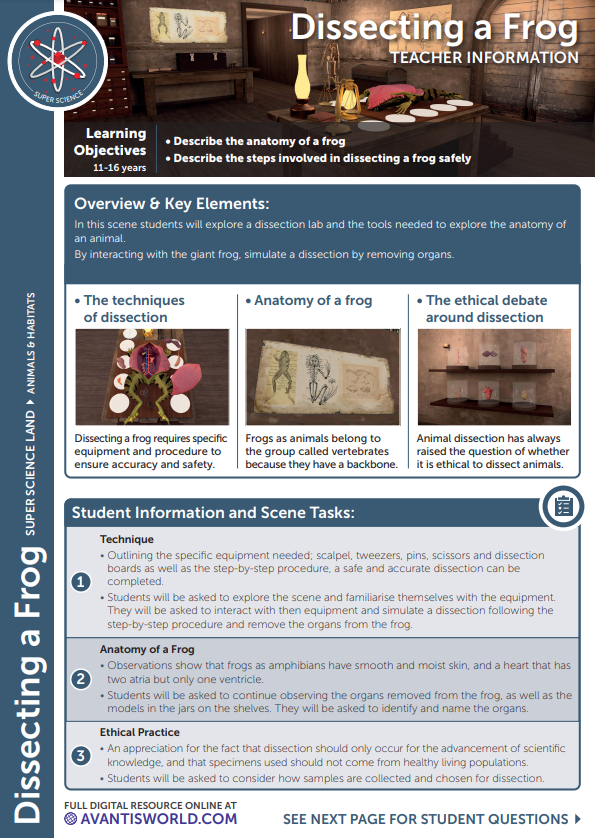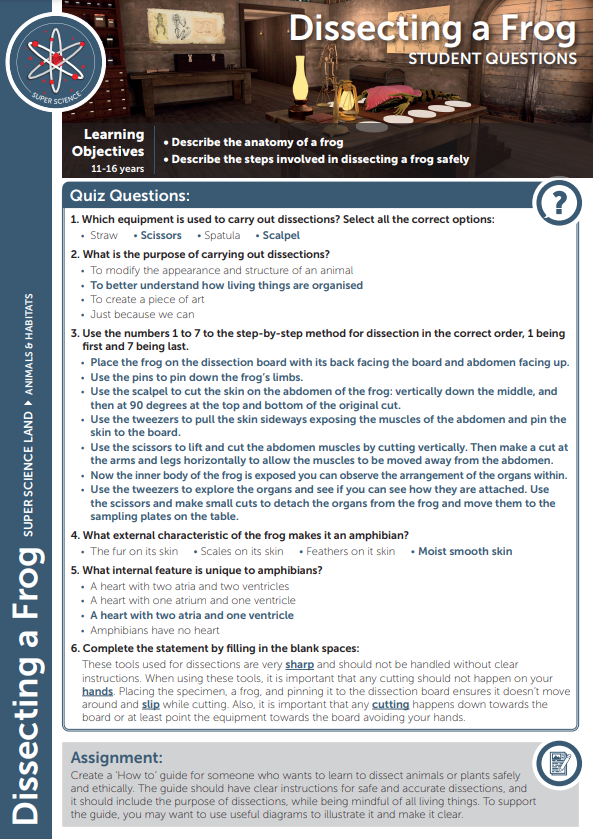 Loading...
Loading...
Initial language selection is based on your web browser preferences.
Take your students into this historic laboratory and let them get their hands messy as they dissect a giant frog. In this scene students will explore a dissection lab and the tools needed to explore the anatomy of an animal. By interacting with the giant frog, simulate a dissection by removing organs from the frog.
# Learning objectives
1: Describe the Anatomy of a Frog{.info}
2: Describe the Steps involved in Dissecting a Frog Safely{.info}
# Technique{.objective .objective1}
Understanding the anatomy of living things requires a specific method for safe dissection and accurate observations of a specimen. Outlining the specific equipment needed; scalpel, tweezers, pins, scissors and dissection boards as well as the step-by-step procedure, a safe and accurate dissection can be completed.
Students will be asked to explore the scene and familiarise themselves with the equipment. They will me asked to interact with then equipment and simulate a dissection following the step-by-step procedure and remove the organs from the frog.
# Anatomy of a Frog{.objective .objective2}
Dissection of amphibians such as frogs allows scientists to make accurate observations, and develop an understanding of their anatomy, as amphibians. Observations show that frogs as amphibians have smooth and moist skin, and a heart that has two atria but only one ventricle. In addition, all other organs will highlight that they are similar to other vertebrates.
Students will be asked to continue observing the organs removed from the frog, as well as the models in the jars on the shelves. They will be asked to identify and name the organs.
# Ethical Practice{.objective .objective3}
Improving and appreciating the organisation of living things requires dissections. The ethical aspect of dissections needs to be considered to ensure that animals aren’t harmed needlessly for the sake of these studies. An appreciation for the fact that dissection should only occur for the advancement of scientific knowledge, and that specimens used should not come from healthy living populations.
Students will be asked to consider how samples are collected and chosen for dissection.
# Teacher Resources
### Download Teacher Notes for Frog Dissection
[](https://data.avncloud.com/activities/806581/files/Dissecting%20a+Frog+Teachers+Notes+1.pdf?date=1692782541&size=1140736&md5=b7ece4989f9f16da6911f3264456b19e)
### Student Quiz Answers Document
[](https://data.avncloud.com/activities/806582/files/Dissecting%20a+Frog+Teachers+Notes+2.pdf?date=1692782702&size=738216&md5=66e6019824781ed49e2505737d82d440)
### Download Student Quiz Document
[](https://data.avncloud.com/activities/806583/files/Dissecting%20a+Frog+Teachers+Notes+3.pdf?date=1692782816&size=95473&md5=43e4e7e47f26da31c0db660cda93db1a)